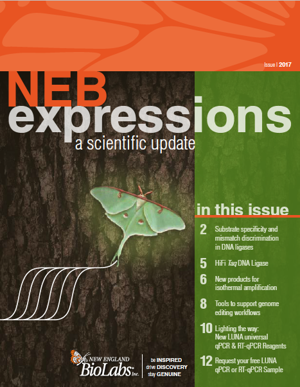Find your product
Advanced searchLogin
Webshop under construction
Due to technical maintenance the webshop is closed until January 3, 4. We wish you a successful 2025!
Welcome
Sign outPersonal information
NEBexpressions - a scientific update: "Substrate specificity and mismatch discrimination in DNA ligases"
 DNA ligases vary in their ability to join fragments, add adaptors, repair nicks or breaks, link vectors and inserts, and to circularize dsDNA. Ligases also vary in their type of activity. The specificity and accuracy of the ligation depends upon ligase selection and careful optimization of reaction conditions. With the right ligase, conditions and probes, even single-base variations in sequence can be reliably detected.
DNA ligases vary in their ability to join fragments, add adaptors, repair nicks or breaks, link vectors and inserts, and to circularize dsDNA. Ligases also vary in their type of activity. The specificity and accuracy of the ligation depends upon ligase selection and careful optimization of reaction conditions. With the right ligase, conditions and probes, even single-base variations in sequence can be reliably detected.
DNA ligases are enzymes that seal breaks in DNA by joining 5´-phosphorylated DNA termini to 3´-OH DNA termini (1-4). In vivo, ligases are important for the repair of nicks, breaks in one strand of a dsDNA molecule, DNA formed during replication (i.e., Okazaki fragments), as well as both nick and double-strand break joining during repair events (5). In vitro, ligases (notably T4 DNA Ligase) are critical reagents for many molecular biology protocols, including vector-insert joining for recombinant plasmid construction, adaptor ligation for next-generation sequencing (NGS) library construction, and circularization of dsDNA (6). T4 DNA Ligase (NEB #M0202) is incredibly efficient at sealing nicks, as well as joining or circularizing DNA fragments with blunt or cohesive (short complementary) ends. This activity can be further improved with the addition of macromolecular enhancers, such as polyethylene glycol (PEG), as seen in NEB’s Quick Ligation™ Kit (NEB #M2200) (7,8).
Less commonly utilized in vitro, Taq DNA Ligase (NEB #M0208) will ligate only nicks (9-12). Taq Ligase is a NAD+-dependent DNA ligase from a thermostable bacterium that can survive high temperatures (up to 95°C) and is active over a range of elevated temperatures (37–75°C). However, it only has significant activity on nicked DNA, and negligible activity on short cohesive and blunt substrates in end-joining reactions. Given these limitations, and the fact that T4 DNA Ligase can ligate everything Taq ligates, and many more structures, why not use T4 DNA Ligase for all applications?
T4 DNA Ligase can ligate a wide variety of DNA structures, including modified bases and the ends of double stranded fragments. It will also efficiently ligate many undesirable structures, including substrates containing gaps of one or more nucleotides and nicked substrates that contain DNA base pair mismatches (12-15). In most cases, this unwanted activity isn’t a problem, for example, when joining 1 or 2 fragments into a plasmid, or pushing an adaptor ligation reaction as far towards completion as possible to prepare high yields of DNA NGS libraries.
For some applications, however, there cannot be any end-joining activity at all, and for others, there is a need for the exclusive ligation of fully base-paired nicks with no gaps. For example, DNA assembly methods, such as Gibson Assembly® (NEB #E5510) and NEBuilder® HiFi DNA Assembly (NEB #E2621), require nick-selective ligases; this method utilizes long overlaps that are dynamically generated by exonucleases and gaps are filled by a DNA polymerase (16,17). Final joining is accomplished by a nick-selective ligase, such as Taq DNA Ligase, which only reacts with substrates containing no gaps, and will not join any fragments end-to-end without the exo/polymerase generation of annealed complementary regions. The use of a nick-selective ligase ensures that fragments are not joined out of order, and no deletions result from ligation across nucleotide gaps in annealed structures.
Download the Free NEBexpressions magazine to read complete article
Printed NEBexpressions magazine
Interested to receive the printed version of this magazine or receive for the printed NEBexpressions magazine in your lab 3 times per year? Complete the form and receive the magazine free of charge*.
*The printed version of the magazine can be sent to addresses in the Netherlands, Belgium and Luxembourg only. Visit www.neb.com for other countries.